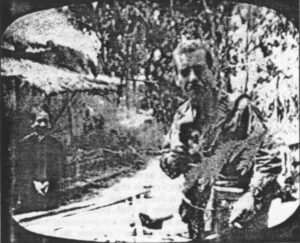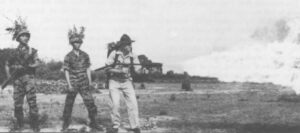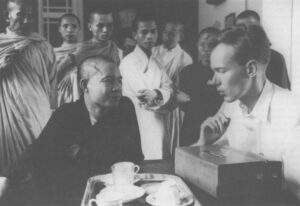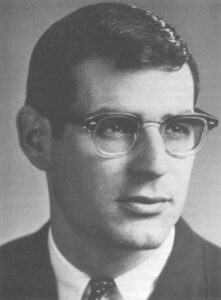Editors Note: APF Reporter Vol.11 #3 exsisted only as a photo copy, becuase of this the pictures in this story are of poor quality.
VIETNAM, 1965
Asia’s early-morning traffic moved the other direction, the Marines seeming to push against the flow of business, business being the work of the hunched old farmers gently flogging their oxen and water buffalo toward market.
It was the way of this place that the old men did not raise their eyes to the alien caravan of armed tractors from America. At the side of the roadway, where laundry flew like truce flags from open shanty huts, the women watched. The older ones stared blankly out of stonily impassive faces. The younger women were different, wildly expressive, with desperately outstretched hands and beseeching beggar wails. But it was the kids who stormed the convoy in an assault wave of urchins, scrawny elbows scraping dangerously against the turning treads, dirty fingers clawing up at the giant men above, toothless grins mouthing a banzai shout: “Number One Yank! Number One Yank!”
The Marines grinned back. The Number One Yanks had seen this movie, watched their hero-fathers in a thousand flickering Hollywood images of wars past. The Marines, like their G.I. fathers, were the good guys. So they shoved their flame throwers, rocket-launchers, and automatic rifles aside; dug into their kit bags, and showered the kids with Hersheys and five-packs of Wrigleys.
Earlier that morning, trying to beat the god-awful heat of Vietnam’s August sun, the Marines had rousted Morley Safer in the half-light of a tropical false dawn. Safer, a 34-year-old television correspondent from CBS, was making the mission today, the target routine, a small but troublesome village just eight miles outside the Marines’ burgeoning base in the northern coastal city of Danang.

The year was 1965, and Vietnam had not yet become a television war. The Marines had been here only five months, although their commander-in-chief, Lyndon Baines Johnson, had begun to gorge their Danang outpost with more and more arrivals. Safer had been here seven months, the first CBS regular in Vietnam, although the networks were beginning to escalate, too.
The days of what had been known in Washington as the “press mess”–back in 1962 and 1963 when stories under print-media bylines of Halberstam, Bigart, Sheehan, Browne, Arnett had scorched the policy-makers a half-world away seemed distantly past. Those were the old days, when American “’advisers” had tried to coach a war-weary and often reluctant people to defend themselves. The press could pick at that, chew at the politics of the earlier American failure, point their inked fingers at the naivete and misunderstandings and endlessly mistaken optimism of American officials. The reporters–young, ambitious, skeptical, downright disrespectful at times–could and did win their Pulitzers, write their books and gain their fame.
But that was over now. The Marines had begun hitting the beaches near here in February, and they were taking over, making a truly American war of this messy little entanglement in Southeast Asia.
Since the end of the Second World War, no fighting man in the world stood taller than the American Marine. He had God on his side and toughness, too. He had been immortalized by earlier generations of war correspondents who had slogged and died alongside him, and he had no reason to expect anything different here.
In the summer of 1965 the American troops viewed television crews with awe, envy, curiosity–a wide range of feelings that did not include suspicion. The television correspondents usually visited the Marines’ outpost for a day or two–a quick hit, looking for some bang-bang, they called it–and then returned to Saigon more than four hundred miles to the south.
They arrived in squads, snarled in cables and batteries and film packs, loaded down with more gear than a general’s aide just in from Hong Kong. In the field their old Auricon cameras and cumbersome crews made better targets than a captain’s bars, and sometimes became beacons for hostile fire. But the troops welcomed the cameras. If television meant a touch of extra danger, it also symbolized a message home to a girl friend, a wife, a mother. The Marines knew the TV crews were looking for the shoot-’em-up stuff on which New York thrived. But so? The Marines were looking for bang-bang, too. That was the name of the game. The Marines saw the correspondents as good, if temporary, companions.
Safer was no exception. At 34, he was older than most of them by just enough to be called “old man–respectfully, as in, “What’s an old man like you doin’ out in this shit when you doan need to be?” Short and square-built, he had a rugged, jut-jaw look about him. He wore his camouflage fatigues just right, usually touched up with the proper amount of mud and never looking as if they had been tailored in sets of ten in Saigon. He could tell good war stories, having been in more wars than the troopers.
He was a Canadian, although the Marines did not know that by talking to him, because Safer didn’t talk “Canadian” and he didn’t talk “teevee.” Perhaps because he was Canadian, he came into the war with a slightly different perspective from other reporters, and some of the leathernecks had heard scuttlebutt that his reporting had a raw edge to it. But Safer had respect for the Marines and he showed it. As a youngster growing up in a working-class family in Toronto, he had seen the same war movies they had seen. And when he had to take the same risks they did, Safer answered: “No sweat.” He was not one of the boys. But the Marines liked him.
So, as the convoy of amphibious personnel carriers clanked noisily through the slum-warren outskirts of town, Safer struck up an easy conversation with his companions. He told war stories about his skirmishes in Algeria and Cyprus. The Marines told stories, too. He was in for a good day, a young Marine lieutenant confided to the man from TV. The job for the day: Punish a village.
Safer didn’t believe him. This lieutenant had seen too many war movies.
Along the roadway the urban babble soon faded to a murmur, the old men, the oxen, the shanty huts and the urchin mobs giving way to an Asian countryside of uncertain sights and quieter sounds. The Marines grew silent and uneasy. The only real sound seemed to be the metallic wrench of the machines. This would not be a surprise attack, Safer thought.
The Marines began tinkering with their tools, clip-checking the assault rifles, preparing projectiles for the rocket-launchers, hitching up the steel backpacks that carried the makings of liquid flame.
Safer began checking his equipment, too. In 1965 a television war correspondent’s tools were at least as complex and surely more awkward than a soldier’s. Safer would move into battle tethered to his two Vietnamese technicians, the three men captives of each other, captives of their technology. They carried one hundred pounds of gear–an old 35-pound, 16-millimeter, sound-on-film Auricon camera; 20 pounds of sound equipment, another 20 pounds in filmpacks and spare batteries, plus the normal stuff you needed to keep yourself alive: Food, water, purification pills, rain ponchos, spare clothing.
Check the film. Three packs, 400-foot rolls each, black-and-white Kodak…
Safer worked in a black-and-white world without satellites to beam images instantly around the globe, without remotes or micro-dishes or million-dollar salaries, without videotape or compact video cameras, without a well-developed journalistic history or tradition, without a full sense of its own raw power, and only beginning to match the political clout wielded by its print rivals. Still, Safer had one foot in a new era, too. Communications technology was moving at a dizzying pace. Color film would arrive in Vietnam momentarily. The first geostationary communications satellite, Early Bird, had been launched over the Atlantic just four months earlier, and television had begun to play with transmitting moving pictures instantly between Europe and the United States.
Less than two years earlier, after the assassination of President Kennedy, television had been given a taste of the emotional hold it could have on the public. For four days it had held a traumatized nation tied to the little screen. But the Kennedy assassination was unique, so naturally riveting in its emotion that it required little more than turning on the cameras. To mesh the rapidly developing technology with the phenomenon of its nearly hypnotic powers, television desperately needed a format for less commanding events–a style that would separate it forever from its natural father, radio, and set it apart irreversibly from its natural rival, the newspapers.
Check the batteries. Three…
Batteries gave out fast in the humidity of the jungle, instantly in a stumble on a river crossing. Lose the batteries and the day might as well have been spent drinking martinis at the Caravelle Hotel down south in Saigon.
Check the couplings…
Inside the Auricon, the film and the audio tape were paired in one strip. This synchronized sound with film, a major advance over days just past when tape recorders picked up only random battlefield noises–wild sound that could be added to the film later. Synchronized sound also moved television light years ahead of the old newsreel days when the thunder from the big guns of the Second World War was drummed up, literally, in the studio. The soundman, contrary to popular thought, did not record sounds. He manipulated them, amplifying distant gunfire to bring it in on top of the scene for dramatic effect or muting the roar of helicopters or the wail of the civilians so the correspondent could be heard. Let the jungle gunk clog those couplings, corrode the wires connecting the three-man team, and the raw power of television’s evolving journalistic style eroded, too.
In New York a new breed of editors, the producers, were demanding a new kind of journalistic art form. They wanted a momentary slice of life from America’s adventure in Vietnam. Preferably with action. Surely with drama. But the story had to be molded—in New York–and the loss of one part of Safer’s team would destroy the mold. The producers wanted 1,200 feet of modulated, moderated, sound-synchronized film. Then they would cut it, splice it, and weave it into the 180-foot, three-minute drama of a mini-movie.
It was a new kind of journalism–bold, powerful, and compelling. It also was confining, frustrating, and soon to be very controversial. Television’s new style was journalism by vignette, and that style, combined with Vietnam and the tumult of the Sixties, would bring television to adulthood.
Ha Thuc Can, speaking in Vietnamese, busied himself in a last-minute rundown with the soundman. And the personnel carriers groaned to a stop.
For a moment silence hung eerily over the convoy. Then came the grumble and clatter of men over the side, starting to move out cautiously in single file, Safer and his crew with them. Off to one side stood a dense tree-line. To the other, a muddy stream meandered lazily. Ahead lay a patchwork of paddies, dotted with small islands of scrub growth. Beyond, just coming into sight of the advancing Marine columns, lay the little village known as Cam Ne.
The sun beat down in a hot slant now and this was the kind of place where, in the paddies, steam wisps turned from mirages to men to mirages again; where, from the jungle, the tangle grasped at you.
The first, short burst of gunfire seemed to come out of nowhere. A shriek punctuated the shots, followed by the agonizing moan of a Marine down. Safer dropped immediately into a half-crouch. Glancing quickly around, he saw no gun-puffs from the murk, no movement in the jungle cover, no hostile action from the village. He saw only Marines, with medics scrambling toward one fallen man wounded in that most painful and humiliating of spots, the buttocks. Safer thought instantly: Oh, Christ, the poor bastard got it from one of his buddies. Some new kid saw a shadow and panicked, or stumbled over a jungle vine with his safety off.
But gunfire in a hostile wilderness does not lead to contemplation. The troops flinched, as Safer had done, and opened up on the village in a chaotic burst from their automatic rifles and rocket-launchers. It seemed over in moments. Bayonets drawn, the Marines stormed in among the smoking huts of Cam Ne. They suffered no further casualties, uncertain to this day if the single downed American was hit by hostile or friendly fire.
No weapons and no fighting-age men were found in the village. Four old men were taken captive and held for questioning which proved to be a problem because none of the Americans spoke Vietnamese and none of the villagers spoke English. In the first barrage, three women were killed. One scrawny ten-year-old boy, who might have been in the urchin brigade on a different kind of visit, was mistakenly shot dead as he attempted to run away.
Very little about the assault on Cam Ne, or the events of the next few minutes, was unusual. By none of the standards of twentieth century warfare could it be considered an atrocity. By none of those standards was it particularly brutal or savage. Cam Ne, in its worst light, was a sad little moment in a place where sad moments occurred every moment. It was, indeed, a vignette, and it became significant–more symbolic and significant in its way than the fire-bombings of Dresden, Tokyo and countless atrocities that took hundreds of thousands of civilian lives in past wars–for only two reasons: The Auricon was there in search of such vignettes and its lens captured American Marines–the good guys who liberated villages and showered kids with candy and gum and took grateful kisses from village maidens waving tiny American flags–the lens, that relentless single eye with no peripheral vision, captured the white hats in a moment of frenzy doing a different part of their job in a very different kind of war.
Safer tugged now against the tethers confining him to his two Vietnamese technicians. “This way, Can,” he urged his cameraman; “Over here, Can,” and New York would leave the tuggings and urgings in the film, as if to add drama to the scene. The camera swung to Marines prodding frightened old men with bayonets, then to old women imploring Safer for help as they were herded out of their burning huts, then to Marines towering over aged prisoners with hands bound, eyes blindfolded, heads drooped, ancient faces lined in rutted roadmaps of despair and fear.
Early in the filming, Ha Thuc Can’s Auricon captured a lone Marine, very young, very American, very much an American mother’s son, standing with his back to the camera, bayonet still protruding from a spent rifle held loosely. The scene was quick, almost subliminal. It ran without commentary from Safer, and needed none. The young Marine casually withdrew his Zippo lighter, as if, duty done, he was ready for a cigarette break. But he put the flame to a straw roof instead. The camera moved on quickly.
The Marines roved in swarms now, their more efficient flame throwers out. The Auricon closed in on giant men with steel backpacks attached to long hoses, the nozzles spraying fiery gelatin onto one thatched roof after another. Thirty, forty, fifty hootches went up and the Auricon caught Safer against a backdrop of flames…
“This is what the war in Vietnam is all about”…and the soundman amplified the wailing noise of the peasants…
“The Marines have burned this old couple’s cottage”…and he muted the background noise as Safer stopped a nervous Marine in the chaos…
‘Were you getting (gun) fire from them?” New York edited the Marine’s uncertain response…”From what? Not too much”…Then Safer was doing his stand-up commentary, pulling the vignette together in a voice filled with certainty and touched with measured poignancy…
“Today’s operation is the frustration of Vietnam in miniature. There is little doubt that American firepower can win a military victory here. But to a Vietnamese peasant whose home means a lifetime of backbreaking labor, it will take more than presidential promises to convince him that we are on his side. Morley Safer, CBS News, near the village of Cam Ne…”
© 1988 William Prochnau
William Prochnau, a freelance writer, is reporting on media coverage of the Vietnam war.




